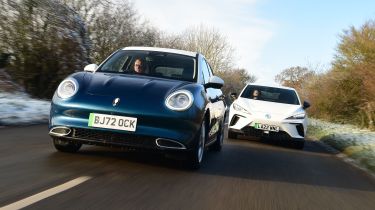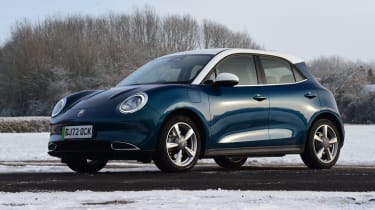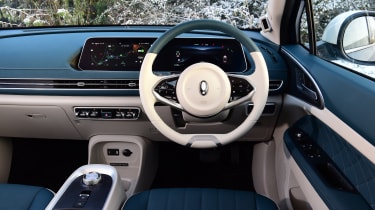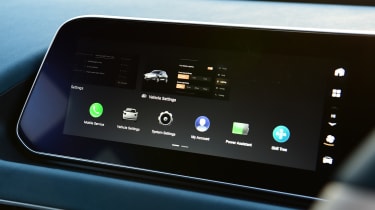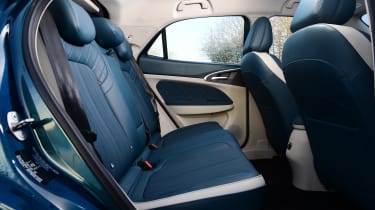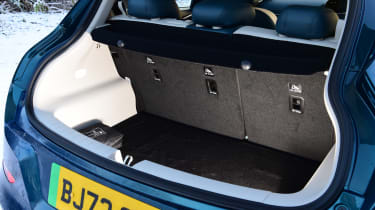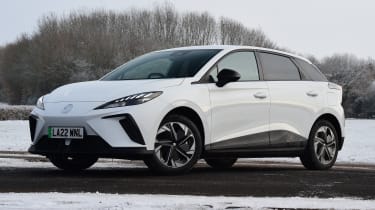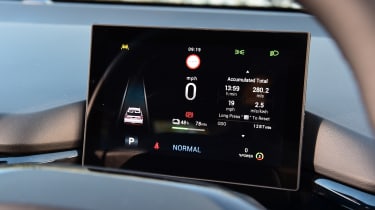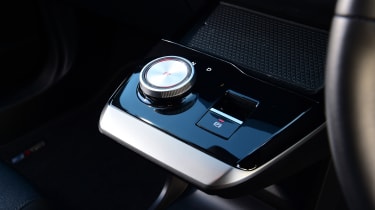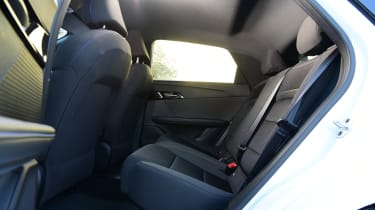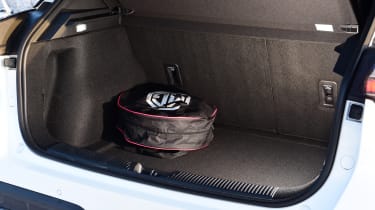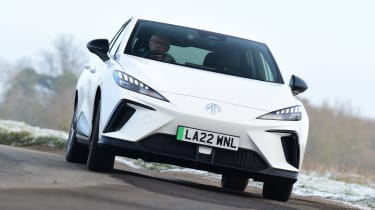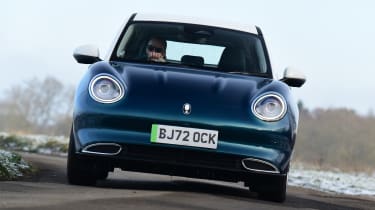Ora Funky Cat vs MG4: 2023 twin test review
The GWM Ora Funky Cat blends electric drive and stand-out style in a value package. Can it beat the MG4?
Take a look at the Chinese Zodiac, and 2023 is due to be the year of the Rabbit. However, if one newcomer to the UK car market has its way, then we could be heralding the year of the Cat instead.
The GWM Ora Funky Cat is the latest in a wave of new metal to emerge from China, with far more set to come along from a variety of brands which, to most UK buyers, will seem unfamiliar. The overwhelming majority of these will be fully electric – and the Funky Cat is no different.
Having sampled the newcomer already, we’ve seen that it shows some promise, so it’s now time to subject it to an in-depth twin test. And there’s no stronger rival for the Funky Cat than the MG4. While it wears an historic British logo on the nose, like Ora, MG is under Chinese ownership – but it’s already proven itself to be a car which could rejuvenate the marque.
While previous MGs have offered value for money as a key selling point, the MG4 also has genuine ability. So can the Funky Cat become another promising new EV, or will the MG4 prove to be too strong?
Ora Funky Cat
| Model: | Ora Funky Cat First Edition 48kWh |
| Price: | £31,995 |
| Powertrain: | Single motor, 48kWh battery, 169bhp |
| 0-62mph: | 8.3 seconds |
| Test economy: | 2.8 miles/kWh |
| Charge speed: | 64kW (15-80% in 43 mins) |
We can’t blame you for being unfamiliar with the Ora brand; even in its native China, it only came into existence in 2018. Since then, a variety of small electric vehicles have rolled off the production line, most of which with a Cat-based name – Black, White, Punk and Big, to name a few.
Used - available now

2023 Audi
Q4 Sportback e-tron
54,526 milesAutomaticElectric
Cash £23,363
2022 Kia
Niro
18,315 milesAutomaticPetrol1.6L
Cash £17,900
2023 Nissan
Juke
40,858 milesManualPetrol1.0L
Cash £12,287
2022 Volkswagen
T-Roc
36,779 milesAutomaticPetrol1.5L
Cash £18,600In other markets, the car you see here is known as the Good Cat, but here it’s called the Funky. In First Edition trim it costs £31,995, which climbs to £32,790 with our car’s Aurora Green paint and white roof.
Design & engineering
From a styling point of view, the Funky Cat certainly lives up to its name. You’re greeted first by the friendly face of its front end; not many cars have round headlamps any more, so you might think it bears a resemblance to a MINI or a Volkswagen Beetle, maybe even a Porsche 911. At just over 4.2 metres long, the Cat is a touch shorter than the MG4 and VW ID.3, and slightly longer than the Renault Megane E-Tech.
The funky theme continues inside. Our car’s two-tone scheme has a green finish to mirror the exterior paintwork which, mixed with the cream plastics lower down and subtle use of (plastic) chrome trim, really helps to give a special atmosphere that only the Fiat 500 can offer for similar cash.
It’s not quite as impressive when you start to touch things, though. The chrome toggles feel a little flimsy, the hard plastic of the centre console isn’t particularly sturdy, and the “lit-when-on” steering wheel buttons remind us of the VW ID.3 – controls which, due to negative feedback, VW will be tweaking when that car is updated. Then there’s the rotary gear selector, which rotates freely like the volume switch on a cheap hi-fi; you need to rely on the illuminated indicator to be sure of the gear you’re actually in.
Driving
The lack of sophistication that’s betrayed by the interior of the Funky Cat can also be felt out on the road. From a low speed, it’s clear that there’s a noticeable level of fidget from the suspension, which compromises comfort around town. At higher speeds that feeling persists, although the overall set-up itself doesn’t feel unduly harsh or firm; it’s certainly no worse than in some electric rivals.
However, there isn’t much compensation in terms of driving fun. Look beyond the lack of body roll, and the Cat feels a little lazy and lumpen through the turns, and it’s not helped by steering which offers little to no feedback.
For most buyers it will be fine, but ‘fine’ isn’t good enough when compared with the MG4. Thanks to the Ora’s electric powertrain, there’s very little noise coming from under the bonnet. However, this highlights a fairly pronounced level of tyre roar, which is more audible than in the MG.
At 8.3 seconds, the Funky Cat’s 0-62mph time is 0.4 seconds behind the MG’s, and this is barely noticeable in the real world. For a car such this, it’s more than sprightly enough around town, while the throttle has enough progression in Normal mode to feel easy to modulate. At speeds above 50mph, the acceleration tails off more than in its rival, though.
A single-pedal driving mode is available, and there are three further energy recovery modes that are selectable via a sub-menu on the touchscreen. The smooth transition between regeneration and mechanical braking is excellent.
Practicality
When it comes to interior space, the Funky Cat is rather hit and miss. It holds a tiny edge over the MG for rear kneeroom, but the roofline is tighter, so taller occupants will feel slightly more cramped. The seats themselves are firm and the squab is short, so those with longer legs might wish for a little more under-thigh support.
However, it’s in the boot where the Funky Cat is most compromised. At 228 litres, the load space is closer to that of some city cars rather than a family hatchback of this size.
Fold the rear backrests down and that figure climbs, but it’s still an underwhelming 858 litres. The opening is both much narrower and higher than the MG4’s, too.
Ownership
Both of these cars received the maximum five-star ratings from Euro NCAP when they were tested in 2022. However, the Funky Cat’s category scores were higher in all but the Vulnerable Road Users Category, where the MG pipped it by just one per cent.
While the Funky Cat’s Driver Assist score is one of the highest of any car that Euro NCAP marked last year, we found its lane-keep assist system to be one of the most intrusive we’ve ever tried. On roads with undefined borders and fading central lines – in other words, pretty much any British B-road – it regularly panics that you’re straying out of your lane, and constantly tugs at the wheel to compensate.
Running costs
This test took place in winter, with temperatures frequently dipping below zero during our week at the wheel of each car – as unflattering for an EV’s efficiency as it’s possible to get.
As a result, we’d have to reserve full judgement on its efficiency until the weather improves, but the MG4 was 0.3mi/kWh more efficient than the Cat’s 2.8mi/kWh in the same conditions.
Given that the MG managed 3.5mi/kWh in a previous, warmer test in which its rival, the Kia Niro EV, managed 3.9mi/kWh, we can conclude that the Funky Cat’s overall efficiency falls short of its rivals’. Combined with its modest battery, a resulting real-world range of 134 miles in cold weather was 57 miles less than the MG’s.
Tester’s notes: “Neither car has a rear wash/wipe. The MG’s oddly shaped rear end is designed to keep road grime at bay, but the Ora really needs a wiper.”
MG4
| Model: | MG4 EV SE Long Range |
| Price: | £29,495 |
| Powertrain: | Single motor, 64kWh battery, 200bhp |
| 0-62mph: | 7.9 seconds |
| Test economy: | 3.1 miles/kWh |
| Charge speed: | 135kW (10-80% in 35 mins) |
Compared with its rival’s Funky Cat name, a simple ‘4’ seems like it’s lacking a little imagination. Still, MG’s first EV developed from the ground up has impressed us already, overcoming the Kia Niro EV in a group test last summer. But its Chinese rival here is much cheaper than the Kia, so can the MG maintain its winning streak?
Here we have an SE Long Range model, which at £29,495 is very competitively priced.
Design & engineering
This pair are electric family hatchbacks from the Far East, but their mechanical make-ups are very different. While the Funky Cat mounts its electric motor at the front and drives the front wheels, the MG4’s motor sits beneath the boot floor and drives the rears. At 200bhp, the MG’s motor makes 31bhp more than its rival’s, but its peak torque of 250Nm is the same.
The MG needs that extra power, because it’s heavier than the Funky Cat. While the pair are similarly sized, much of that extra mass comes down to the MG4’s larger battery, which offers 64kWh to the newcomer’s 48kWh. In official WLTP tests, that means the MG4 is able to cover 270 miles on a single charge, compared with 193 miles for the Funky Cat.
Step inside, and the MG’s black, slightly featureless cabin looks almost unfinished beside the Funky Cat’s. Build quality is no worse, though.
Both cars have their own advantages when it comes to the driving position. The Funky Cat’s dashboard is slightly lower than the MG4’s, which means that you can more easily judge distances to the front of the car. However, the MG’s oddly shaped steering wheel has a greater range of adjustment, so it’s easier to get comfortable.
The physical buttons on the wheel feel more pleasing to use than its rival’s, although the position of the door-mirror adjustment, on the dash beside the wheel, means you have to lean forward a little, making it harder to get the mirrors in the right position.
Driving
There are very few EVs on the market that are fun to drive – especially ones at the more affordable end of the market. However, the MG4 is a rare exception. The rear-wheel-drive layout certainly helps, but the mix of a modest amount of body roll, quick steering and a fairly neutral balance means that it’s quite an engaging family hatchback on a B-road. If you are in the market for an electric car that’s a little more enjoyable to drive, then the MG4 is certainly a great place to start.
This decent handling hasn’t come at the expense of comfort, either. Not only is the MG4 more agile than the Funky Cat through the corners, but its suspension set-up is also more forgiving at any speed, too. Bumps are fairly well absorbed across a variety of surfaces, and both suspension knocks and tyre roar are slightly better suppressed.
It doesn’t matter which driving mode you choose, the MG’s throttle is sharper and more responsive than the Ora’s. As a result, it feels much more darty in town, making it easy to jump into gaps in urban traffic. At higher speeds, this response teams with the chassis to deliver a neutral balance on the exit of corners. The steering itself has a pleasing weight to it, with a feeling of resistance gently building as you load the tyres up through a corner.
This sharpness isn’t quite matched by the brakes, though; the regeneration system feels a little more spongy than the Funky Cat’s reassuring pedal.
Practicality
The clearest advantage the MG holds over its rival in terms of practicality is at the back. Even though its motor is rear-mounted, there’s still a 363-litre boot – 125 litres larger than the Ora’s. Fold the seats down, and the 1,177-litre total is 319 litres ahead.
The MG4 has roomy back seats, too. A lack of foot space beneath the front seats is a minus point, but the MG is more comfortable than the Funky Cat for three, because the centre seat is wider and there’s a softer backrest. Both cars have slightly awkward access to the Isofix mounting points; we prefer the plastic surrounds the likes of VW use on its vehicles than the large velcro fabric panels used by the MG4.
When it comes to storage up front, the MG has a large centre cubby with a lid, two cup-holders and a decent centre bin. The Funky Cat’s storage is similarly useful, although the glovebox is quite shallow and the rear door bins are a little small.
Ownership
Charge speeds will play a big part in EV ownership for those who cover long distances – and this becomes more important for models with smaller batteries.
To that end, the Ora is a little disappointing, with a maximum charging speed of 64kW. That means a 15-80 per cent charge – 86 miles of range, based on our wintry figures – in 43 minutes. The MG’s 135kW charging results in a 10-80 per cent charge – or 134 miles – in 35 minutes. The MG’s plug is in a similar position to most combustion cars’ filler caps, while the Funky Cat’s is on the front nearside wing.
Both cars offer long warranties: a five-year, unlimited package for the Funky Cat and seven-year/80,000-mile cover for the MG.
Running costs
If you’re a private buyer, then residual values count for a lot when it comes to an overall cost-per-mile figure. To this end, the MG is going to be the far cheaper option here. Not only does it cost less to buy in the first place, but this SE Long Range model is also predicted to hold on to an impressive 66.9 per cent of its value after three years or 36,000 miles.
The Funky Cat’s 50.6 per cent figure over the same period means that it will lose almost £16,000 in that time, compared with less than £10,000 for the MG.
Tester’s notes: “Later this year, MG plans to release a hot version of the MG4. Its twin-motor, four-wheel-drive set-up is rumoured to offer in excess of 400bhp.”
Results
First place: MG4
The MG takes its second victory in an Auto Express group test. We’re impressed by the MG4 in many areas: the way it handles, its compliant ride, the strong performance, the spacious cabin and decent boot, plus its competitive – if not quite class-leading – efficiency. Most of all, though, alongside almost any other EV on sale today, it offers great value, so its minor flaws are so much easier to forgive.
Second place: Ora Funky Cat
Some cars grow on you the more you live with them. The Funky Cat is one that makes a fabulous first impression, but begins to reveal areas that have room for improvement the longer you spend with it. Some will be charmed by its design alone, and the price is still competitive in the wider EV market, but against the MG, it struggles to keep up across the board.
Other options in this category
Renault Megane E-Tech Techno
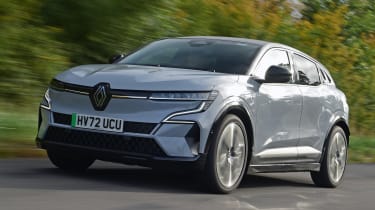
- Price: £39,495
- Power: 60kWh battery, 217bhp
Increase your budget, and the Renault Megane E-Tech is a cracking alternative. It’s great to drive, spacious and has some of the best in-car tech in the segment. It’ll comfortably top 200 miles between charges in the real world, too.
MINI Electric Level 2
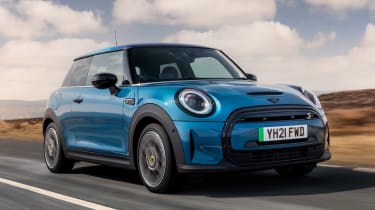
- Price: £31,000
- Power: 32.6kWh battery, 181bhp
More stylish than the Funky Cat and more fun to drive than the MG, the MINI Electric feels like a much higher-quality product than either. The trade-off is that the MINI is more cramped inside and has a much shorter range.
Figures
| MG4 SE Long Range | GWM Ora Funky Cat First Edition | |
| On the road price/total as tested | £29,495/£29,495 | £31,995/£32,790 |
| Residual value (after 3yrs/36,000) | £19,717/66.9% | £16,199/50.6% |
| Depreciation | £9,778 | £15,796 |
| Annual tax liability std/higher rate | £114/£228 | £128/£256 |
| Annual electricity cost (12k/20k miles) | £1,316/£2,194 | £1,457/£2,429 |
| Insurance group/quote/road tax cost | 28/£645/£0 | 21/£551/£0 |
| First service cost | N/A | £200 (est) |
| Length/wheelbase | 4,287/2,705mm | 4,235/2,650mm |
| Height/width | 1,504/1,836mm | 1,603/1,825mm |
| Powertrain | Rear e-motor/lithium-ion battery | Front e-motor/lithium-ion battery |
| Peak power | 200bhp | 169bhp |
| Peak torque | 250Nm | 250Nm |
| Transmission | Single-speed/rwd | Single-speed/fwd |
| Battery capacity/usable | 64/61.7 kWh | 48/48 kWh |
| Boot capacity (seats up/down) | 363/1,177 litres | 228/858 litres |
| Kerbweight/payload/towing capacity | 1,685/448/500kg | 1,540/430kg/N/A |
| Turning circle | 10.6 metres | 11.2 metres |
| Basic warranty (miles)/recovery | 7yrs (80,000)/1yr | 5yrs (unl’td)/5yrs |
| Driver Power manufacturer/dealer pos | 28th/N/A | N/A |
| NCAP: Adult/child/ped./assist/stars | 83/80/75/78/5 | 92/83/74/93/5 |
| 0-62mph/top speed | 7.9 secs/100mph | 8.3 secs/99mph |
| AE economy (miles/kWh)/range | 3.1/191 miles | 2.8/134 miles |
| Claimed range (WLTP) | 270 miles | 193 miles |
| Charging capability | 7.2/135kW | 7.2/64kW |
| Charging time | 9h/35 min* | 7h 30 min/43 min** |
| CO2/tax bracket | 0g/km/2% | 0g/km/2% |
| Airbags/Isofix/park sensors/camera | Eight/yes/f&r/yes | Seven/yes/r/360 |
| Auto/lane keep/blind spot/AEB | Yes/yes/no/yes | Yes/yes/yes/yes |
| Climate control/cruise control | Yes/yes | Yes/adaptive |
| Leather/heated seats | No/no | Faux/no |
| Metallic paint/LED lights | £545/yes | £795/yes |
| Keyless go/powered tailgate | Yes/no | Yes/no |
| Sat-nav/digital dashboard | No/yes | Yes/yes |
| DAB radio/connected apps | Yes/yes | Yes/yes |
| Wireless charge/CarPlay/Android Auto | No/yes/yes | Yes/no^/no^ |
Now read our list of the best electric cars on sale...

